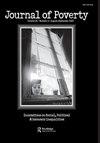利用两个可比较的住户调查数据集估算减贫的增长半弹性
IF 0.8
Q3 SOCIAL WORK
引用次数: 0
摘要
摘要该研究使用两次可比较的家庭调查来估计贫困增长半弹性,该调查不包括2019年的调查,因为它是一个基准年调查,因此在技术上与早期的调查不具有可比性。贫困增长半弹性估计表明,经济增长每提高一个百分点,贫困状况就会恶化得越多。结果进一步表明,1%的增长所产生的预期贫困发生率低于增长5%或10%或更高时的预期贫困发生率。一个重要的发现是,在选择贫困指数时,对贫困增长半弹性的估计对边际变化的反应非常敏感。关键词:弹性,增长,家庭,尼日利亚,贫困,半弹性,调查数据致谢作者在此感谢匿名独立专家审稿人对本文的宝贵意见和建议。我还要感谢在各种会议和研讨会上发表本文早期版本的讨论者和与会者,感谢他们提出的宝贵意见和建议。作者对本刊编辑和编辑助理的承诺表示感谢。披露声明作者未报告潜在的利益冲突。数据可用性声明本研究使用了从尼日利亚国家统计局免费获得的公共数据(HNLSS 2020和NBS, Citation2004)。本文章由计算机程序翻译,如有差异,请以英文原文为准。
Estimating Growth Semi-Elasticity of Poverty Reduction Using Two Comparable Household Survey Datasets
ABSTRACTThe study estimates poverty-growth semi-elasticity using two comparable household survey which excludes the 2019 survey since it is a base year survey, thus, not technically comparable with earlier surveys. Poverty-growth semi-elasticity estimates suggest that the more the percentage point rise in growth, the more poverty would deteriorate. Results further suggest that the expected poverty incidence generated by 1% of growth is less than the expected poverty incidence when growth is either 5% or 10% or more. A major finding is that the estimates of poverty-growth semi-elasticity are highly responsive to marginal changes when choosing among poverty indices.KEYWORDS: ElasticitygrowthhouseholdNigeriapovertysemi-elasticitysurvey data AcknowledgmentsThe author hereby acknowledges the contributions of anonymous and independent expert reviewers for their valuable comments and suggestions on the manuscript. I would also like to thank discussants and participants at various conferences and seminars where earlier version of this article was presented for their valuable comments and suggestions. The author is grateful to the Editor(s) and Editorial Assistant(s) of the journal for their commitment.Disclosure statementNo potential conflict of interest was reported by the author(s).Data availability statementThe study used public data (HNLSS 2020 and NBS, Citation2004) obtained freely from the National Bureau of Statistics (NBS) of Nigeria.
求助全文
通过发布文献求助,成功后即可免费获取论文全文。
去求助
来源期刊

Journal of Poverty
SOCIAL WORK-
CiteScore
2.60
自引率
10.00%
发文量
26
期刊介绍:
The Journal of Poverty is the first refereed journal to recognize the inequalities in our social, political, and economic structures, presenting progressing strategies that expand society"s increasingly narrow notions of poverty and inequality. The journal"s broad understanding of poverty—more inclusive than the traditional view—keeps the focus on people"s need for education, employment, safe and affordable housing, nutrition, and adequate medical care, and on interventions that range from direct practice to community organization to social policy analysis. The journal"s articles will increase your knowledge and awareness of oppressive forces such as racism, sexism, classism, and homophobia that contribute to the maintenance of poverty and inequality.
 求助内容:
求助内容: 应助结果提醒方式:
应助结果提醒方式:


